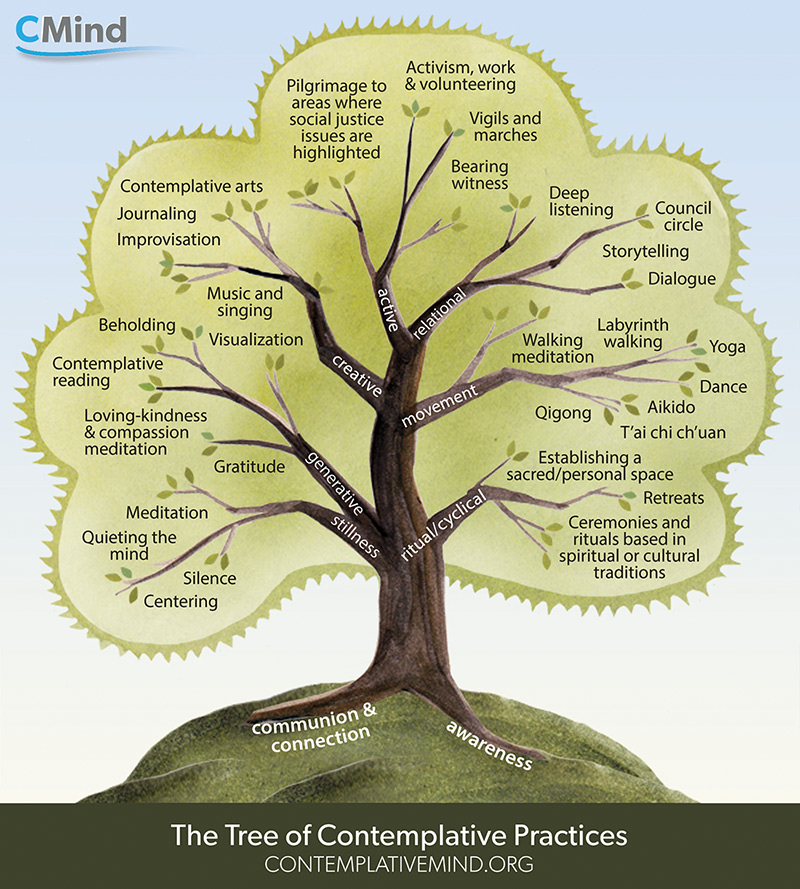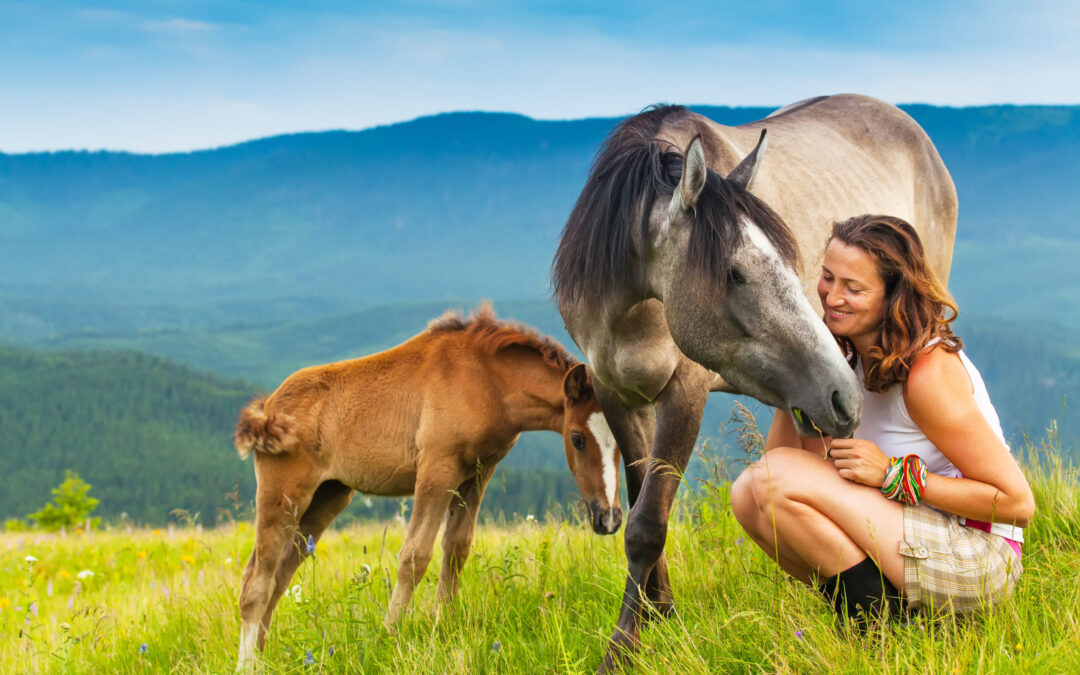What is Contemplation?
I think therefore I am……
Or is it, I am therefore I think?
If I don’t think, AM I?
Wait! What does thinking have to do with who I am? Or who you are?
Really…
Who AM I?
Who ARE you?
Who are WE?
Surely each of us has pondered these sorts of questions to some degree at some point in our lives. At the very least they may have given us pause (or made our heads spin) in a high school or college philosophy class.
Recently, a friend and colleague posted a wonderful graphic illustrating a tree of contemplative practices currently in use in academic and organizational settings.The tree depicts that there are two essential roots (sources) of contemplation, several limbs (categories of practices), and many, many branches (specific practices). This is such a helpful image because it’s not uncommon to have one notion stuck in our minds, limiting our engagement with a process that we all need more than ever.

Image credit: CMind. (2021). The Tree of Contemplative Practices [Illustration]. The Center for Contemplative Mind in Society. https://www.contemplativemind.org/practices/tree
For example, the word “contemplation” may bring to mind an image of a bald monk in a robe sitting on a meditation pillow. Some would then dismiss it as irrelevant to their lifestyles or their belief systems. Likewise, it may conjure up an image of a person deep in thought, leaving many to assume that contemplation is mainly for philosophers, scientists or artists, or for times when really big decisions require careful discernment.
A Different Way of Knowing
One of the dilemmas in talking about Contemplation (similar to talking about Love, or just about anything for that matter) is that “knowing” it through experience and “knowing about” it intellectually are two very different kinds of knowing. To talk about contemplation (objectively) is not a door into it, generally speaking.
We’ll come back to this, but first let’s start with understanding something about the words, contemplation and contemplate. When wanting to know about something, what better place to start than Google?
When I google “contemplation” or “contemplate”, what first pops up are dictionary definitions:
con-tem-pla-tion (noun)
- the action of looking thoughtfully at something for a long time
- deep reflective thought
- the state of being thought about or planned
If you click “view more definitions”, you also see that contemplation can refer to:
- religious meditation
- (in Christian spirituality) a form of prayer or meditation in which a person seeks to pass beyond mental images and concepts to a direct experience of the divine
con-tem-plate (verb)
- look thoughtfully for a long time at
- think about
- think profoundly and at length; meditate.
It would seem that according to common English usage, the terms contemplation and contemplate are tied to a way of thinking and/or to a spiritual sort of meditation.
This seems like a reasonable objective, surface understanding.
On an experiential level, anyone who has intentionally pursued contemplation might add, contemplation is cultivated through practice.
Contemplation is Cultivated by Practice
If contemplation is cultivated through practice, then what are we cultivating?
- a quality of the action of looking (described as looking thoughtfully at something for a long time)
- a quality of thought (described as deep, reflective thought – which means thought that sees itself, or that is aware of itself)
- a state of being (described as being thought about or planned; but I prefer ‘a state of knowing and being known’ or, ‘a state of being connected’)
So, to define contemplation from the perspective of one who engages in contemplative practice:
Contemplation is a way of seeing, thinking, and being
in relationship to ourselves and to others,
and to the immediacy of each moment –
receiving what is offered
and offering our authentic selves
to each moment and each relationship.
It is about how we move in the dance of Life
Co-creating
THIS present moment
and THIS relationship
by
choosing
and re-choosing
Connection.
Contemplation is the state of knowing and being known, of seeing and being seen.
Contemplation is CONNECTION.
Contemplative practice is the practice of cultivating our capacity for connection.
The anonymous author of the medieval classic, The Cloud of Unknowing, states, “God cannot be thought. God can only be loved.” The contemplative Christian tradition recognizes that the purpose of prayer is relationship. Prayer is a practice of connection. Centering Prayer, which is one type of contemplative practice, begins with my intention to consent to God’s presence and action within me. It is a willingness to remain open to the received experience of one’s connection with God. Buddhists may describe this as a receptivity to fully engage in the experience of the present moment. This is a kind of relationship with reality itself and the universal rhythms that find expression in each phenomenon at each particular moment.
Whether one practices contemplative Christianity or Buddhism, or one of the many other contemplative paths, the practice of contemplation is that of consent. Because our minds will wander, the practice is to continually return to one’s intention to assume the stance of least resistance to the relationship. The intention is to say yes to connection, again and again. This stance requires a different quality of awareness than that of our ordinary consciousness. Maintaining this internal quality of connected awareness has been described as a quivering bead of mercury – collected, but fragile. It easily scatters with too much or too little pressure. In other words, we cannot force ourselves (or others) into this connected quality of being. We must allow ourselves and others to experience this quality of being. It’s not about acquiring; it’s about letting go… consenting, cooperating.
Natural Lifemanship is a Contemplative Practice.
Natural Lifemanship is a practice of cultivating connection in relationships. The process is guided by principles such as:
- The principle of choice (Healthy connection is always a choice; if it’s forced or coerced, it’s not the kind of connection that heals and transforms.)
- The principle of pressure (In the process of cultivating connection, it is my responsibility to be aware of and to manage the pressure that I communicate with my body, my energy, my thoughts, intentions and behavior; this requires A LOT of self awareness and self work. Just like with the quivering bead of mercury, pressure supports connection – but not too much or too little.)
- The principle of attachment and detachment (True connection requires a sense of security in both attachment, which is being with, and detachment, which is being apart. We experience both attachment and detachment in our relationships all the time, including in our relationship with the divine or with universal truth. Contemplative practice avails us to both experiences of connection, simultaneously. We are never more connected with the reality of the present moment than when we let go, neither clinging to nor resisting that which comes into our awareness.)
Natural Lifemanship is a healing, relational process that transforms those who practice it. It is a contemplative practice that builds our awareness of and attunement to ourselves and others. It is a practice by which we learn to let go of our own resistance to connection, even as we help THIS person or THIS horse do the same. We continually ask of ourselves and the other, am I (are you) ignoring the invitation to connect? Am I/are you resisting it? Where does this resistance reside in my body, or in my horse’s body, and when I notice it, can I let it go, or invite them to let it go? Can I be attuned enough to my equine partner to notice tension in his or her body before it even shows up as resistant behavior, and can I meet her with just the right amount of energy at that moment? When she experiences that her resistance isn’t going to push me away, nor is it going to make me resort to power, domination or control, she will find that letting go, even a little, feels amazing. Likewise, I may find that staying present in the discomfort of resistance, or of being ignored, invites me to let go of the well worn patterns that have governed my relationships with others, with myself, and within my spirituality for a very long time.
NL is a relational practice. We help each other assume the stance of least resistance to the deep, rewarding connections that are available to us if only we would consent to them. We get to be that rewarding connection for others and we get to allow others to be it for us.
Learn More
If you are interested in a retreat style experience that explores how contemplative practices can transform your way of being in relationships join us for Natural Lifemanship for Spiritual Connection, October 6-8th, 2022 at the Natural Lifemanship Headquarters in Brenham, TX.
Check out our related blogs:
Spiritual Intimacy Grows with Connection through Detachment
The Gift of Being Our Truest Selves



Recent Comments